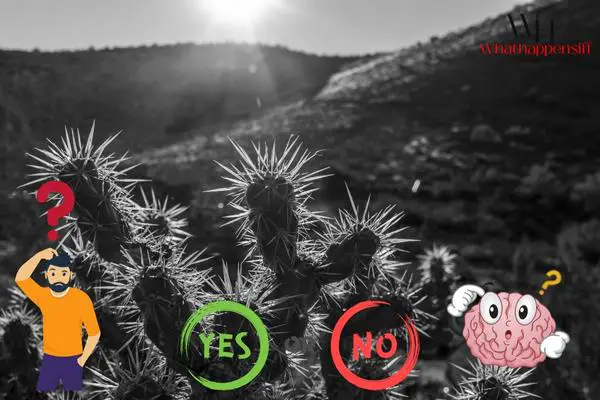Hiker’s warning: “Stay away from Cactus and Wildflowers”
If you are planning hiking you should know how to identify Jumping Cactus.
It’s very simple to identify due to the “hanging chain fruits” on it. If you touch them or step on it would really mind this!
Your next step will be to scream with pain and call someone to help you to get off the spines. Nasty Jumping Cholla can shoot needles if you touch them slightly. They did not actually jump
What makes jumping cactus jump? In reality, they dont jump deliberately. When someone passes close to them with fabric or skin touching the cactus, it immediately broke from its loose joints. After this, the spines on it get stuck to fabric or skin that rubs against causing pain.
If you step on them, they will spring up and get attached to your shoes or feet. If your shoes are not solid the spines can easily reach your feet. You can see these segmented chollas along the trails.

What Is Jumping Cactus
Jumping Cactus is a type of cactus plant also known as Jumping Cholla. This plant got this name because of its ability to jump or fly off to your body as you get close to it. It grows in segments and can separate off as someone approaches it.
This plant grows in the Sonoran desert and southwestern parts of the USA. It grows above altitude in valleys, slopes, and rocks. The estimated height where it grows is 4000 feet. It grows in a wild environment where it has the ability to thrive and keep itself safe from humans and animals.
Do Jumping cactus Actually Jump
How can a plant or cactus jump? Is it true or Myth? Although the nickname jumping cactus suggest that it would be a jumping plant deliberately. People might think after reading this name that the cactus would jump on them to sting in reality. What is true?
Do Jumping Cactus really jump? The reality is that it does not jump. Its segmented body or lose joints will detach easily when someone slightly rubs against it. After detachment, the stings will stick to your body and you are likely to suffer pain. This is why people say that it can jump.
The soft and furry segments of this plant can easily lose their actual position to stick to the rubbing object. Suppose your clothes or hands get in touch with any segment, it will break off easily to attach to your body, clothes, or hands.
By jumping, it means the plant deliberately does so after seeing a human or animal. It’s not the case here. The light and stingy appearance of this cactus can make it attach to any surface that slightly brushes or rub over it.
What Makes Jumping Cholla Jump
From the above heading, it’s clear that Jumping cholla never jumps, it’s just a name. However, when you pass by this plant and accidentally your clothes or body part brush over it you feel as if it has stung you. Even you can see the stings in your body. It seems as if the plant has jumped to you to attack. Reality is different from what you feel.
What makes jumping cactus jump? Firstly segmented parts of this cactus have sticky stings that can sting anyone who gets close to it or touches it. Secondly, its lightweight joints are very easy to break even with a slight rub or touch. Finally, It’s not easy to get rid of it once attached to your body or clothes.
What Kind of Cactus Jump at You
Cactus belongs to the plant family Cactaceae having 127 genres and more than 2000 species. It grows in all parts of the world from mountains to deserts. You can even find it in the desert because of its ability to store water. Cactus species have got interesting nicknames as moving devil cactus, jumping cactus, pokey pigs, Prickle Rick, and jumping cholla.
What kind of cactus jump at you? Only Jumping Cholla or teddy bear cactus has the ability to attach to your clothes or skin if you rub it slightly. Though almost all kinds of cactus have spines yet only jumping cholla can stick to animals’ and humans’ skin if they get closer.
What Happen If You Get Stung By Jumping Cactus
Many hikers and animals when passing close to jumping cactus never care about its stings. As a result, they scream with pain when get stung. The next trouble is obviously how to get off the spines, that really hard! You should have knowledge of whether they are poisonous or not.
What happens if you get stung by a jumping cactus? It’s really painful when fishy stings of this cactus attack you. It can cause irritation or infection if spines go deep into your skin. After getting off it may also leave spots that last for a few days to weeks. Good thing is that they are non-poisonous.
What To Do If Someone Gets Pricked By Jumping Cactus
It’s really painful when someone gets pricked by a jumping cactus. It’s even more, troubleshooting to get rid of the spines. Though prickles are non-toxic yet they cause bruises, cuts, and bleeding.
Some sprinters are even harder to remove. You are likely to feel pain even after removing the spines.
What to do if someone gets pricked by Jumping cactus? The first thing to do is to drop warm water to make the area soft to be able to get off the spines. You can also add salt to the water to avoid infection. Use a needle or tweezer to remove the spines To check if all spines are removed touch the area. If you feel no pain on pressing the skin it means it is spine free.
Remember dont try to rub the affected area. In this way, pickles will move more deeply.
Facts About Jumping Cactus
Jumping Cholla and Jumping Cactus both are the same plants. There are many interesting things about these cacti that you need to know. Let’s check out the 10 facts below:
- Jumping Cholla grows like a tree. It can gain a height of 4 to 15 feet.
- Its trunk is covered with a wrat-like outgrowths
- Its stem consists of numerous segments
- This cactus has the ability to store water and perform photosynthesis with it
- They grow close to others forming forests
- The whole body of the jumping cholla has spines to protect itself from animals and humans
- The blooming season of this plant starts in February and ends in March
- The flowers are yellowish-green in color and grow at the edge of branches
- This plant also develops a fruit that is pear-shaped
- Its fruit stores water and its important reserve of water in summer for der and lambs in deserts
Most Asking Questions
How Does The Jumping Cactus Jump on You?
They do so only when you touch or rub them with your skin or fabrics slightly. If you stay far away from it they are calm. They only attach when animals or humans get close to them. They are very springy so that even a skylight touch can make them attach to your fabric and skin.
When you get close to the plant the pieces will pop off and attach to your skin. Yikes!
How Far Can a Jumping Cactus Jump?
In reality, they dont jump until someone touches them. They are light enough and covered with prickly spines that attack ultimately in response to any slight rub, brush, or touch. It’s advisable to stay 3 feet away from this cactus as they may have a lot of dropping close to the plant.
Are Jumping Cactus Poisonous?
No, they are non-poisonous but very spiky and stingy. They can cause cuts, bruises dead skin tissues, spots, bleeding, and even infection. They are very challenging to get off. The remaining spines inside the skin may cause infection if they stay there for a long time. Use warm salty water to remove them and avoid infection.
Conclusion
Almost all types of cacti are spiny. Some species are calm and dont attack, while cholla is a naughty one. However, if you stay away from it you can avoid its attack. They only shot needles when someone approaches them, otherwise, they’re calm!
These spines are very helpful for this cactus. They help them to thrive and survive in deserts. It is because of them that animals dont like to eat them.

